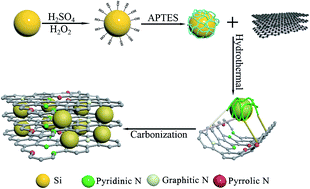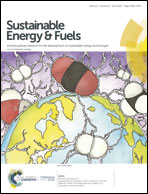Self-assembly encapsulation of Si in N-doped reduced graphene oxide for use as a lithium ion battery anode with significantly enhanced electrochemical performance†
Abstract
Silicon is considered as an anode for next generation lithium ion batteries owing to its low discharge potential (∼0.4 V vs. Li/Li+) and high theoretical specific capacity (3500 mA h g−1). However, the drawbacks of Si, such as the low electronic conductivity, formation of an unstable solid electrolyte interphase (SEI), and extremely high volume expansion, limit its practical application. In this work, a silicon/nitrogen-doped reduced graphene oxide (Si/N-doped rGO) nanocomposite consisting of modified Si tightly wrapped in the rGO is prepared by a one-step hydrothermal process followed by carbonization. With nitrogen doping, the electronic conductivity and lithium-ion diffusion coefficient (DLi+) of the N-doped rGO are significantly improved. Meanwhile, the uniform distribution of Si particles along the N-doped rGO network and the intimate contact between them are able to efficiently buffer the volume change during repeated charge/discharge processes. Therefore, as compared with Si/rGO, the Si/N-doped rGO composite anode presents significantly improved electrochemical performance, delivering a reversible specific capacity as high as 1790 mA h g−1 with an initial coulombic efficiency of 77.6% and a capacity retention of 77.8% after 100 cycles at 200 mA g−1.



 Please wait while we load your content...
Please wait while we load your content...